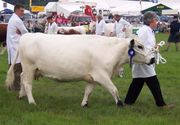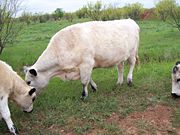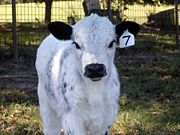Wikipedia British White History
January 2008
The Wikipedia British White Cattle History seems to be a
continuously moving target so I thought it would be good to post a
static page of what it was at some given point in time. This is from
British White Cattle Wikipedia, the free encyclopedia archived in
January 2008. Actual Wikipedia pages have been edited many times
since.
British White cattle are the polled variety of the indigenous
Park Cattle of the British Isles. The polled British White can be
either red or black pointed, and from the 17th to 19th centuries we
know from estate records that some English owners preferred the red
point, while others preferred the black point; and there was
swapping amongst the owners who had a strong preference for either
red or black points.

British White cattle are a naturally polled (hornless) breed, with a
milk white coat and black or red points. The colored points are
about the ears, nose, eyes, teats, tongue, and hooves and often have
speckles of black or red about the body, and splotches of color on
the lower leg. The skin beneath the hair is usually a quite pale
pink or black, with stronger color beneath their spots. This colour-pointed
pattern is found in several equally ancient cattle breeds throughout
the world.
Formerly the British White was a dual-purpose animal,
producing both beef and milk, but the modern focus for the animal is
for meat production. The dual-purpose heritage means that many cows
are good milk producers, alloBritish White femalewing calves to grow
very well when the cows' diet consists of grass alone.

British Whites are also able to thrive on very poor pasture such as
marshland and heathland, making them suitable for use in managing
natural pasture habitats of high nature conservation value. The
British White is very docile – sometimes becoming so much so that
herding them becomes difficult and they must be led using feed as
bait, or one must train them to come to your call in hopes of treats
or fresh pasture.
HISTORY
The British White is a British cattle breed dating back in
modern history as far as the 10th Century where we find legal
reference to the Park Cattle in regard to customary tributes paid to
the Lord of Dynevwr Castle, located in Wales. There is no mention of
the white cattle with red ears paid in tribute as being horned,
although today the Dynevwr herd is the horned variety of Park
Cattle. As well, reference is made to to the

milk white, red-eared, hornless cattle as far back as the 8th
century in the recording of the "The Tain Bo' Cualgne", the oldest
epic tale in Western European literature, which scholars generally
agree is based on actual events beginning in 30 B.C. in Ireland
during the rule of King Conchobar of Ulster. Predominant cattle
mentioned in The Tain include the great White-Horned Bull, but with
no mention of red or black points, and the regular mention of milk
white, hornless, red-eared heifers. Due to various natural
catastrophes over the centuries the cow we now know as British White
became extant on the Isle of Erin (Ireland), though there can be no
doubt of the reverence of the breed by the Celtic Irish of 2000
years ago.
The originating name of Park Cattle
resulted from the enclosure or 'emparking' of vast acreage following
the Norman Conquest of 1066. In the ensuing centuries, the emparked
acreage produced herds of white cattle, and the term 'wild', not
necessarily indicative of feral, was applied to them, as they roamed
freely on these vast estates. These uniquely colored cattle were
kept as ornamental and sporting animals in the enclosed parks for
many subsequent centuries following the Norman Conquest, and they
included both horned and polled individuals, and by 1918 the Park
Cattle Society was formed and included both the horned and polled
variety of the white Park Cattle in the herd books.
It has been
suggested that the polled variety of Park Cattle (British White) may
have been brought to the British Isles by the Vikings or
the Romans, and there are at least superficial similarities with
Scandinavian breeds such as the Swedish
Mountain cattle and other European breeds, including the colour-sided
Irish breed, the Irish
Moiled. However, there are ample historical and literary sources
available today that show these claims to be without merit, and in
fact the milk white cow with red/black points well pre-dates the
incursions of the Vikings and the Romans. The presence of the polled
British White is deeply woven into ancient Celtic historical tales
of as long ago as 30 B.C.
Records indicate
a herd of polled white cattle in Northern
England in the 17th century. These cattle were kept in the Park
of Whalley
Abbey, in the Forest
of Bowland near Clitheroe.
After that time, the major portion of the herd was moved to Norfolk,
in the early 1800s. This herd was sold off in small lots, largely to
nobility in the surrounding countryside. By the early 20th century
the breed had declined to about 130 registered animals, mainly in
the eastern counties of England, but since then numbers have
recovered with about 1,500 registered animals in the UK, perhaps
2,500 in the US, and many in other parts of the world such as
Australia.
Sir Claud
Alexander, owner of the Faygate herd, writing in the 1912 "Amateur
Menagerie Club" Year Book says:"I would, however, strongly advise
anyone who may think of forming a herd to go to the polled variety
for his foundation stock, for they have been kept from time
immemorial for their milk and beef producing qualities, and right
well do they justify their existence... The Somerford cows are
excellent milkers and one of mine averages five gallons a day when
in full profit. In addition to this they are big heavy beasts and
give a good return from the butcher when their milking days are
over.... Mr Quinton Gurney's herd at Northrepps Hall is a thoroughly
practical one, for on it devolves the task of keeping the town of
Cromer supplied with milk. At Woodbastwick too, some grand milkers
are to be found, and here great attention is paid to beef producing
powers, as the records of the local fat stock shows frequently
testify... If anyone who reads these notes and feels inclined to
form a herd will communicate with me, I shall be pleased to supply
any information that may be required."
In the early
1940's the two groups of Park cattle breeders split and the breed
name of the horned variety was formally changed to White Park, and
the breed name of the polled variety was formally changed to British
White. The Woodbastwick family in England played a key role in the
saving of the ancient polled Park Cattle. "As can be clearly seen,
the breeders of these cattle were engaged in a continual struggle to
maintain numbers, and from time to time the blood of other breeds
was introduced in order to avoid problems associated with
in-breeding and to achieve the desired type. (The article on page 7
of the 1998 British White Breed Journal by Mr J Cator gives a full
account of these outside sources used between 1840 and 1918 in the
Woodbastwick herd)." (source: British White Cattle Society - UK) It
is during this same period of time that English Longhorn, Welsh
Black, and Scottish Highland were introduced into the horned Park
Cattle herds in order save the breed. (Source: Hall, 1991) As well,
Park Cattle bulls of the polled (British White) variety were
introduced. (Source: Auld, 1888)
An impending
invasion by Germany in 1941 caused concern in Britain about Hitler's
intentions. It was feared that Hitler might try to destroy the breed
entirely.[citation
needed] Five cows and one bull were shipped to a
prison farm in Pennsylvania.
These and other bulls shipped from England and other animals
imported from Australia formed
the basis of the British White breed in North
America.
"The horned
White Park of today is the product of the infusion of “English
Longhorn, Welsh Black and Scottish Highland”. (Hall, 1991) Hall goes
on to say “This is because it (White Park) originated when several
ancient herds of white cattle were merged and in all of these there
had been crossing with other breeds.” The horned White Park herds of
today have a variety of horn shape and length rather than
exclusively the ancient classic lyrical shape tipped with black.
In the United
States the first breed registry for these cattle was formed or
incorporated in the state of Iowa as a not for profit corporation on
23 October 1975 under the name of the "White Park Cattle Association
of America" as corporation number 64755. Public records are on line
at the Iowa
Secretary of State website. Search Databases/Iowa Corporations.
Not unlike the
Park Cattle Society in Great Britain circa 1918 - 1940's this new
association recorded both horned and polled animals in the same
herdbook.
On 16 December
1987 a group of breeders headed by Tom Zimmerman spun off from the
"White Park Cattle Association of America" and started the "British
White Cattle Association of America, LTD." Also an Iowa not for
profit corporation number 119073. See the public records on line at
the Iowa
Secretary of State website. Search Databases/Iowa Corporations.
Not unlike the
"British White Cattle Society of England" that was formed in the
1940's as a result of the split within the "Park Cattle Society" the
"British White Cattle Association of America, LTD" was for polled
animals only.
Also in the
United States there is another organization that records only the
horned cattle. This group is headquartered at the B
Bar M in Montana.
In the 1990's
the Oklahoma State University started their Breeds
Of Livestock website. Apparently in an attempt to keep down
confusion and properly identify cattle recorded by each of these
three associations they became known as American
White Park, White
Park for the Ancient White Parks and British
White.
This helped to
better identify the animals recorded by each group but did not
totally eliminate the confusion.
During the early
to mid 1990's there were discussions and negotiations between the
boards of the "White Park Cattle Association" and the "British White
Cattle Association" researching for enough common ground to merge
the groups into one association and register only polled cattle.
These talks eventually failed because the "White Park Association"
group wanted to keep "Park" in the name and the "British White
Cattle Association" group felt it should be only "British White."
Still later,
after the mid 1990's, another attempt at merger efforts were
discussed and negotiated between the "White Park Cattle Association"
and the "British White Cattle Association." It also failed with the
name issue being the main point of contention.
Shortly after
the failed attempt in the 1990's a group representing the "White
Park Cattle Association" formed a new Iowa corporation under the
name "American British White Park Association of America, Inc." Iowa
corporation number 225813. See the public records on line at the Iowa
Secretary of State website. Search Databases/Iowa Corporations.
The "White Park
Cattle Association of America" was merged into this new
organization, under certificate number W00216275 on 29 July 1999.
See the public records on line at the Iowa
Secretary of State website. Search Databases/Iowa Corporations.
Today, January
2008, the websites for the three USA organizations can be found at: http://www.whitecattle.org for
the British White Park Association http://bbar.com/www/parkcattle for
the Ancient White Park Cattle Association http://www.britishwhite.org for
the British White Cattle Association of America
###
|